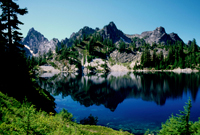Wilderness
 A designated Wilderness area is where nature is untrammeled and humans are the visitors. Through federal and state laws, 834,000 acres, about half of the Mt. Baker-Snoqualmie National Forest is designated as Wilderness established by the Wilderness Act of 1964. A wide variety of plants and animals can be found in these areas. You will find that each Wilderness area provides a unique and primitive experience.
A designated Wilderness area is where nature is untrammeled and humans are the visitors. Through federal and state laws, 834,000 acres, about half of the Mt. Baker-Snoqualmie National Forest is designated as Wilderness established by the Wilderness Act of 1964. A wide variety of plants and animals can be found in these areas. You will find that each Wilderness area provides a unique and primitive experience.
Please review regulations and permit information associated with Wilderness areas and always use Leave No Trace techniques to help keep these areas wild, clean, and pristine.
- Alpine Lakes Wilderness
- Boulder River Wilderness
- Clearwater Wilderness
- Glacier Peak Wilderness
- Henry M. Jackson Wilderness
- Mount Baker Wilderness
- Noisy-Diobsud Wilderness
- Norse Peak Wilderness
- Wild Sky Wilderness
Know Before You Go
Wilderness Regulations
- The goal of wilderness management is to provide a pristine environment. Visitors can help preserve this unique landscape by careful planning and following the regulations. Each Wilderness may have additional rules and requirements specific to that area.
Wilderness Permits
- Day-use visitors to many Wilderness areas may need to fill-out a free, self-issue permit at ranger stations and trailheads. Carry a copy of the permit with you and deposit a portion in the box at the trailhead.
- Overnight visitors to the Alpine Lakes Wilderness Enchantment Lakes area in the Okanogan-Wenatchee National Forest June 15 - Oct. 15 must obtain an overnight Wilderness permit for the area's five separate permit zones: Core Enchantment, Snow Lake, Colchuck Lake, Stuart Lake and Eightmile/Caroline areas.
Recreation Passes
- Some trailheads require a valid recreation pass. Check our Recreation Passes and Permits page for details.
Tips for Safe Wilderness Travel
- Wilderness travelers can take precautions to reduce the chance of backcountry emergencies. Have proper equipment, bring the 10 essentials, tell someone where you are going and when you will return. Weather can change suddenly in the mountain environment. Pack accordingly to avoid hypothermia or heat-related illnesses. Treat all water with a filter, iodine or by boiling for 10 minutes.
Alerts & Warnings
- Mallardy Ridge Trailhead and FSR 4030 and 4032 Closure
- Harris Lake Trailhead and FSR 5510 Closed
- Middle Fork Camping Closure
- Delays possible on PCT at the Summit at Snoqualmie Ski Area
- FSR 4110 Road Closure
- Camping Restrictions
- Fireworks and Explosive Targets Prohibition
- Read this Before Climbing or Backpacking on Mt. Baker
- Hwy 542 Closed to Artist Point
- New food storage rules for Mt. Baker-Snoqualmie NF
- Alcohol Prohibitions

